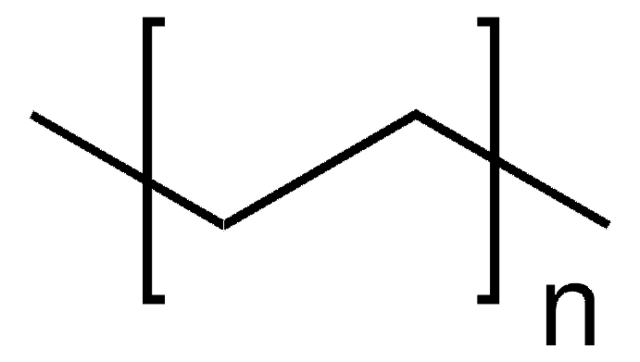03394
Poli(etilenglicol)
tested according to Ph. Eur., 6,000
Sinónimos:
PEG
Iniciar sesiónpara Ver la Fijación de precios por contrato y de la organización
About This Item
Fórmula lineal:
H(OCH2CH2)nOH
Número de CAS:
Número MDL:
Código UNSPSC:
12352104
ID de la sustancia en PubChem:
NACRES:
NA.21
Productos recomendados
Agency
tested according to Ph. Eur.
Nivel de calidad
Formulario
solid
mol peso
5000-7000
solubilidad
aliphatic hydrocarbons: slightly soluble
organic solvents: soluble
aplicaciones
pharmaceutical (small molecule)
cadena SMILES
C(CO)O
InChI
1S/C2H6O2/c3-1-2-4/h3-4H,1-2H2
Clave InChI
LYCAIKOWRPUZTN-UHFFFAOYSA-N
¿Está buscando productos similares? Visita Guía de comparación de productos
Aplicación
Poly(ethylene glycol) was used as hydrophilic carriers for characterizing the sirolimus solid dispersion nanoparticles.
Acciones bioquímicas o fisiológicas
Polyethylene glycol (PEG) is a condensation polymer of ethylene oxide and water. It enhances the refolding of extracted proteins. This enables characterization of crystallized proteins.
Nota de preparación
Poly(ethylene glycol) dissolves in many organic solvents and is readily soluble in aromatic hydrocarbons. It also slightly dissolves in aliphatic hydrocarbons.
Código de clase de almacenamiento
11 - Combustible Solids
Clase de riesgo para el agua (WGK)
WGK 1
Punto de inflamabilidad (°F)
Not applicable
Punto de inflamabilidad (°C)
Not applicable
Equipo de protección personal
Eyeshields, Gloves, type N95 (US)
Elija entre una de las versiones más recientes:
¿Ya tiene este producto?
Encuentre la documentación para los productos que ha comprado recientemente en la Biblioteca de documentos.
Los clientes también vieron
J L Cleland et al.
Bio/technology (Nature Publishing Company), 10(9), 1013-1019 (1992-09-01)
Previous studies on the refolding of recombinant bovine carbonic anhydrase B (CAB) indicated that polyethylene glycol (PEG) significantly enhanced the recovery of active protein by reducing aggregation. To further test the ability of PEG to enhance refolding, three recombinant human
J L Cleland et al.
The Journal of biological chemistry, 267(19), 13327-13334 (1992-07-05)
Polyethylene glycol (PEG) inhibited aggregation during refolding of bovine carbonic anhydrase B (CAB) through the formation of a nonassociating PEG-intermediate complex. Stoichiometric concentrations of PEG were required for complete recovery of active protein during refolding at aggregating conditions. For example
Min-Soo Kim et al.
International journal of nanomedicine, 6, 2997-3009 (2011-12-14)
The aim of this study was to improve the physicochemical properties and bioavailability of poorly water-soluble sirolimus via preparation of a solid dispersion of nanoparticles using a supercritical antisolvent (SAS) process. First, excipients for enhancing the stability and solubility of
Idalis Villanueva et al.
Acta biomaterialia, 5(8), 2832-2846 (2009-06-11)
The pericellular matrix (PCM) surrounding chondrocytes is thought to play an important role in transmitting biochemical and biomechanical signals to the cells, which regulates many cellular functions including tissue homeostasis. To better understand chondrocytes interactions with their PCM, three-dimensional poly(ethylene
Mark A Rice et al.
Acta biomaterialia, 5(1), 152-161 (2008-09-17)
Ultrasound has potential as a non-destructive analytical technique to provide real-time online assessments of matrix evolution in cell-hydrogel constructs used in tissue engineering. In these studies, chondrocytes were encapsulated in poly(ethylene glycol) hydrogels, and gel degradation was manipulated to provide
Nuestro equipo de científicos tiene experiencia en todas las áreas de investigación: Ciencias de la vida, Ciencia de los materiales, Síntesis química, Cromatografía, Analítica y muchas otras.
Póngase en contacto con el Servicio técnico



